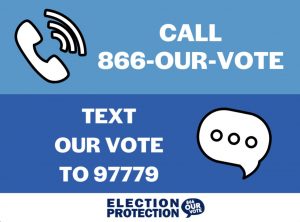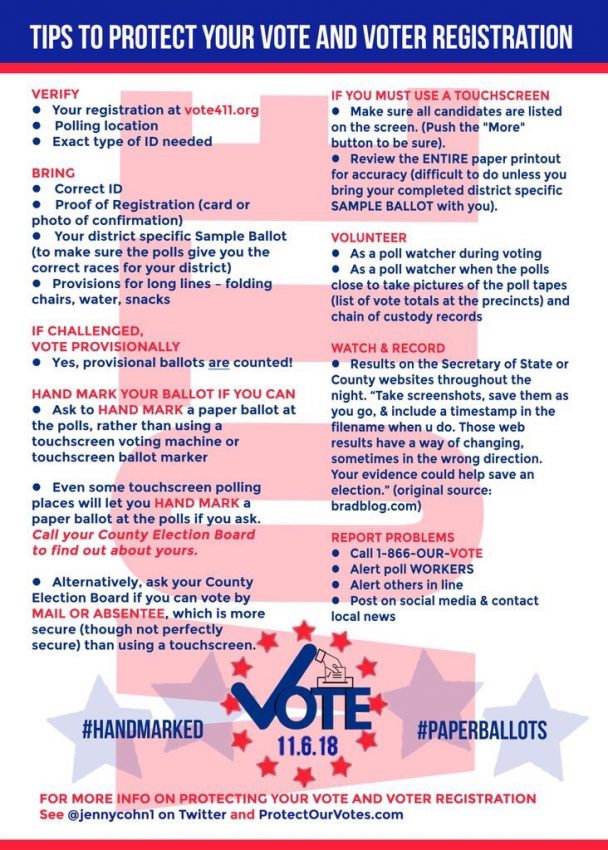 Before the next election, you may be looking for ways to step up to help make sure that more people will vote, are able to vote, and know their voting rights and their local voting rules, and to try to ensure that everyone’s votes will be properly counted.
Before the next election, you may be looking for ways to step up to help make sure that more people will vote, are able to vote, and know their voting rights and their local voting rules, and to try to ensure that everyone’s votes will be properly counted.
If you haven’t already signed up with a group or a campaign to help Get Out the Vote (GOTV) or to help with election protection efforts (e.g., serving as a poll worker or poll monitor or hotline volunteer), below are links that will make it easy for you to get plugged in. Pick one (or two) groups or activities and sign up as soon as possible so that you can get whatever training and materials you need. And if you’re willing to go to a swing state or swing district near you, get on board right away so you have enough time to make your plans. You don’t have to be an extrovert; there are all sorts of GOTV activities to choose from.
Further down this post, we’ve also listed where you can go to find voting guides or other information about who and what will be on your ballot, so that you can do your research and be as well-informed as possible about what you’ll be voting on before you go vote.
Poll workers
Become a poll worker in your city or county (via WorkElections.com, or Power the Polls, or Poll Hero)
Also see this compendium of state-by-state requirements:
Be a Guardian of Democracy, Be a Poll Worker!
Poll monitors / watchers / observers
Common Cause: Volunteer to be an Election Protection poll monitor
Election Protection’s Protect the Vote: Volunteer, non-partisan poll monitors
Election Protection / We the Action: Field Program (for lawyers, paralegals, legal professionals, and law students)
NOTE: Parties and campaigns also assign poll monitors to the polls.
Hotline volunteers
Election Protection / We the Action: Call Center (for lawyers, paralegals, legal professionals, and law students)
Get Out the Vote (GOTV) groups
(reaching out to registered voters via texts, calls, door-to-door canvassing, postcards, or events, etc., to increase voter turn-out)
- Local and state-level campaigns (pick one to volunteer for!)
- Your local and state Democratic Party
- Mobilize, Indivisible groups, Swing Left, Flippable, Sister District, Stand Up America, etc.
- DLCC, DSCC, DCCC, Democratic Governors Association, Democrats Abroad
- NextGen America
- MoveOn
- Fair Fight
- The Last Weekend
- When We All Vote
- Postcards to Voters
- Rock The Vote
- Let America Vote
- Headcount
- Lyft is offering free or discounted rides to the polls, through partner orgs
Note: Some states allow same-day voter registration on Election Day. As of 2018, they include: California, Colorado, Connecticut, DC, Hawaii, Idaho, Illinois, Iowa, Maine, Minnesota, Montana, New Hampshire, Utah, Vermont, Wisconsin, and Wyoming. (And North Dakota doesn’t require registration.) A few states (including CA and MT) also allow in-person, late registration in the days/weeks leading up to Election Day. Other states may be adding same-day/Election-Day voter registration soon. Contact your county’s elections office for details on voter registration deadlines and Early Voting options. (Most states offer an Early Voting period.)
For a list of additional GOTV and voting advocacy groups (and more tips), see our earlier post.
Voting Guides, Voter Education: What and Who Is On Your Ballot?
These sites can help you learn about the candidates and the issues that you’ll be voting on:
- Vote 411
- Vote Smart
- Ballotpedia
- Voter’s Edge (for California only)
- Politifact (Note: Some states have their own state-specific Politifact sites/FB pages.)
To be really well informed, also be sure to read the information provided in your state’s and county’s official voting/ballot guides (they should be mailed to you, or be available on your state and county elections websites). I’d also recommend reading multiple editorials and endorsements from trusted newspapers in your state and from trusted organizations (e.g., your local Sierra Club chapter, your state’s League of Conservation Voters, your state’s or city’s League of Women Voters, NRDC Action Fund, Let America Vote, Emily’s List, Planned Parenthood, or VoteVets.org). Be wary of claims made in TV and radio ads and mailers. Many ads (though not all) are funded by special interests, rather than groups that represent the public interest (the common good). Also, mailers could fraudulently claim to be from your local party or other entity, or could contain other false information (about voting dates, poll locations or hours, your registration status, voter ID requirements, etc.). Beware, and do not allow yourself to be intimidated or suppressed from going to to vote. If in doubt about your local voting rules or poll location, check with your county’s elections board/office or your Secretary of State’s elections office.
Election Security and Voting Rights
At the very least: Make sure you bring the correct ID or proof of residency/address (if your state requires that; see VoteRiders or contact your state’s elections office to find out exactly what’s required). Vote early if your area offers Early Voting options (then you’ll have more time to help others get out to vote on Election Day). If you are in one of the states or counties that uses electronic touchscreen voting machines, ask if you can use a hand-marked paper ballot instead. And you should make sure you get your ballot receipt after voting, and keep it until the election has been certified and you’ve verified with your county or state that your vote was counted.
If you experience or witness any voting problems or irregularities, report them immediately to the Election Protection hotline: 1-866-OUR-VOTE (866-687-8683) [or 1-888-VE-Y-VOTA for Spanish); or text “Our Vote” to 97779. (Put those numbers in your phone now.) Also report problems to your County elections office and your Secretary of State; and if the problems are not resolved, you could also report them to your state’s party, the DNC, local campaign headquarters, and/or to local media or on social media. If a poll worker tells you that your voter registration isn’t active or is incorrect in some way, please contact the 866-OUR-VOTE hotline before you accept a provisional ballot or before you give up and leave.
Some states that have done massive/overzealous “purges” of voters from their voting rolls in recent years (per the Brennan Center) and/or who have a recent history of using voter suppression tactics, include: Alabama, Arkansas, Arizona, Colorado, Florida, Georgia, Kansas, Illinois, Indiana, Maine, Nebraska, Nevada, New York, North Carolina, Ohio, Texas, Virginia, and Wisconsin. So these are states that need extra GOTV and election protection (e.g., poll watching, and well-informed poll workers) assistance and vigilance. [Note: Of those 18 states, the only ones that currently allow same-day/Election-Day registration are: Colorado, Illinois, Maine, and Wisconsin. So if voters in those states have been wrongfully purged, they can re-register on Election Day and vote.]
Check out (and distribute) the tips sheet below for some additional recommendations, and you can find more information on election protection/security and voting rights here:
“Tips (many not obvious) to Protect Your Voter Registration and Vote Against Hacking and Glitches,” by Jenny Cohn, attorney and election integrity advocate
- Protect Our Votes
- All On the Line
- Let America Vote
- VerifiedVoting
- Brennan Center: Protect the Vote
- Lawyers Committee for Civil Rights Under Law: Voting Rights Project
- NAACP Legal Defense Fund
- League of Women Voters
- Fair Fight
- ACLU: Voting Rights
- Greg Palast’s Voter Purge Lists (for GA, CO, IL, IN, NV, NE)
Also see our new posts:
Make It Count: How to Protect Your Vote and Everyone Else’s
State-by-State Voting Information for the 2020 Election
and our earlier post:
Voting and Election Tips and Resources, 2018
Please read and share/post this tips sheet. Thank you!!



{ 0 comments… add one now }